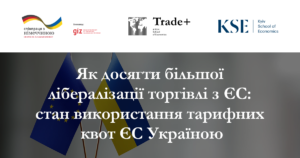- Kyiv School of Economics
- What is the way for achieving greater trade liberalization with the EU: Ukraine’s fulfillment of EU tariff quotas
What is the way for achieving greater trade liberalization with the EU: Ukraine’s fulfillment of EU tariff quotas
On January 1, 2020, the trade part of the Ukraine-EU Association Agreement on the Deep and Comprehensive Free Trade Area (DCFTA) came into force. The agreement stipulates that, five years after its entry into force, that is, in 2021, the parties may engage in consultations as to accelerate and expand tariff obligations.
The practice of fulfilling the quotas indicates that duty-free volumes for agricultural and food products are often too low in terms of current export and production potential of Ukraine’s agricultural sector, which has changed significantly compared to the period when the DCFTA was negotiated.
The analysis shows the positive dynamics of the EU tariff quotas being filled by Ukraine during 2016-2019 – both in terms of the number of quotas used and the volume of exports within these quotas. There is a positive tendency to increase the level of quotas fulfillment for goods with a higher degree of processing. Moreover, actual exports for part of the quotas are far outweighed by duty-free deliveries within the quotas.
The results of the Trade+ analysis of the level of use of quotas and actual volumes of exports to the EU indicate which products Ukraine should prioritise in reviewing the terms of the access to the EU market.
Read the full report prepared by the Foreign Trade Research Center Trade+.
The Center was established at the Kyiv School of Economics in the framework of the project “Promotion of a Supportive Framework for Trade in Ukraine”, that is implemented by the Deutsche Gesellschaft für Internationale Zusammenarbeit (GIZ) GmbH on behalf of the German Government.


